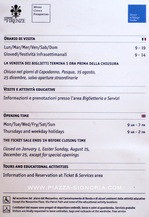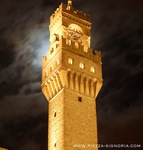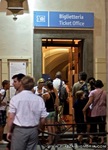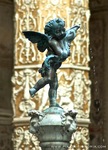Palazzo della Signoria, better known as Palazzo Vecchio, has been the symbol of the civic power of Florence for over seven centuries. Built between the end of the thirteenth century and the beginning of the fourteenth to house the city's supreme governing body, the Priori delle Arti and the Gonfalonier of Justice, over time it has been subject to a series of extensions and transformations.
Its current appearance is mainly due to the splendid restoration work and interior decoration carried out in the mid-sixteenth century to adapt the building to its new function as ducal palace as ordered by Cosimo I de' Medici. After the transfer of the Medici court to Palazzo Pitti, it continued to host the Guardaroba (where the ceremonial costumes and family treasures were stored) and various governmental offices, until it became the seat of the Florence City Council in 1871.
Much of the Palazzo Vecchio is now a museum, although the mayor's office and other local government offices are also located inside.
 The Cortile di Michelozzo should not be missed - it is adorned with stuccoes and frescoes, and in the middle is Verrochio's Putto with Dolphin (a replica - the original is inside the museum). This is the courtyard you enter from the front set of stairs or main entrance (where the David and other sculptures are) that open onto Piazza Signoria across from the Loggia dei Lanzi (the west side of the building). You can enter this area free of charge, but you will need a ticket for the museum from the ticket office that is in the inner courtyard further along. (The building is now accessible from all four sides and metal detectors and other barriers have been removed.)
The Cortile di Michelozzo should not be missed - it is adorned with stuccoes and frescoes, and in the middle is Verrochio's Putto with Dolphin (a replica - the original is inside the museum). This is the courtyard you enter from the front set of stairs or main entrance (where the David and other sculptures are) that open onto Piazza Signoria across from the Loggia dei Lanzi (the west side of the building). You can enter this area free of charge, but you will need a ticket for the museum from the ticket office that is in the inner courtyard further along. (The building is now accessible from all four sides and metal detectors and other barriers have been removed.)
 Once you have a ticket you mount the stairs and continue on to the first floor (2nd American floor!) and enter the Salone dei Cinquecento (Hall of The 500), a massive interior space that is still in use today for conferences, celebrations and government events. The room is dominated by a majestic cycle of paintings celebrating the life of Cosimo de' Medici and the city of Florence, and a rich array of statues including Michelangelo's Victory. This is where some art historians and scholars believe a painting by Leonardo da'Vinci is still hidden behind later works of Vasari.
Once you have a ticket you mount the stairs and continue on to the first floor (2nd American floor!) and enter the Salone dei Cinquecento (Hall of The 500), a massive interior space that is still in use today for conferences, celebrations and government events. The room is dominated by a majestic cycle of paintings celebrating the life of Cosimo de' Medici and the city of Florence, and a rich array of statues including Michelangelo's Victory. This is where some art historians and scholars believe a painting by Leonardo da'Vinci is still hidden behind later works of Vasari.
 On the second floor of the museum are the private rooms of the Medici court, all sumptuously decorated and furnished, and among these the marvellous Cappella di Eleonora, the chapel with paintings by Agnolo Bronzino. Important testimonies of the Palazzo's oldest decorations are kept in the Sala dell'Udienza and the Sala dei Gigli, where the original of Donatello's Judith is also found. In the Sala delle Carte Geografiche an exceptionally large globe and more than fifty painted panels provide an extraordinary glimpse of all the parts of the world known in the sixteenth century. The mezzanine floor houses a remarkable collection of paintings and sculptures from the Middle Ages and Renaissance left to the city of Florence by Charles Loeser.
On the second floor of the museum are the private rooms of the Medici court, all sumptuously decorated and furnished, and among these the marvellous Cappella di Eleonora, the chapel with paintings by Agnolo Bronzino. Important testimonies of the Palazzo's oldest decorations are kept in the Sala dell'Udienza and the Sala dei Gigli, where the original of Donatello's Judith is also found. In the Sala delle Carte Geografiche an exceptionally large globe and more than fifty painted panels provide an extraordinary glimpse of all the parts of the world known in the sixteenth century. The mezzanine floor houses a remarkable collection of paintings and sculptures from the Middle Ages and Renaissance left to the city of Florence by Charles Loeser.
 The museum has a very good website with more details of the visit: Palazzo Vecchio Museum
The museum has a very good website with more details of the visit: Palazzo Vecchio Museum
Tel. +39 055 2768325
Weekdays: 9:00am to 7:00pm
Thursdays and week-day public holidays: 9am to 2pm
Closed on Christmas Day
comments powered by Disqus








